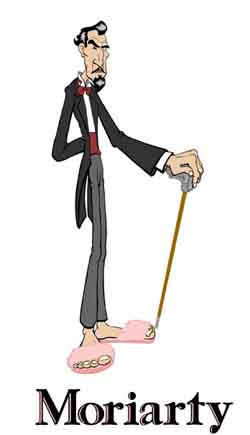Hi, everyone. "Moriarty" here with some Rumblings From The Lab...
Popping up more and more often these days is MiraJeff, and before he gets down to his review, he’s got something to say to those who called him a plant when he reviewed BLADE TRINITY recently:
Hi Harry, hi Drew (can I call Moriarty "Drew" now?), MiraJeff here with a review of Robert Stone's documentary, "Guerilla: The Taking of Patty Hearst." It's an interesting, quirky project that makes for an entertaining history lesson, so post it up if you think it's relevant to AICN readers.
Allow me to clarify a few things to the Talk Backers about the Blade 3 piece, if you will. I messed up on the year, my bad, wasn't thinking. For vamp movies in between Lost Boys and Blade, yes Interview was good, I forgot, but please stop with the JC's Vampires and From Dusk Til Dawn. Also, I am not a plant. That would be easy to figure out since I don't just review one studio's movies, you can search AICN's archives to prove it. Why would I review a movie from a studio I wasn't employed by? Is being called 'a plant' a compliment, because the review could be considered professionally written well enough to pass as a studio spy? I don't know but I felt personally attacked on the message board, which isn't cool. I'm one of the geeks, trust me. Anyone who wants to lambast me can do it directly, or if any editors need a NY-based critic, just email me. Thanks and onto the review.
“Death to the fascist insect,” proclaim the Symbionese Liberation Army at the outset of Robert Stone’s documentary, “Guerilla: The Taking of Patty He arst.” Stone pulls out all the stops with this biting look at the media frenzy surrounding newspaper heiress Hearst’s kidnapping and the extremes her captors went to in order to spread their political platform.
Surviving SLA members Russ Little and Mike Bortin serve as narrators, guiding the audience on a rollercoaster ride of Bay Area broadcast news outtakes and grainy security camera footage. To understand the SLA’s message, one must understand where they were coming from, and Stone does a commendable job of outlining the political climate and hostile atmosphere our country was shrouded in throughout the late 60’s-early 70’s. Stone incorporates footage from the Vietnam War, the Nixon Watergate scandal, and the Kent State shootings before settling his film down at UC-Berkeley, which had become a hotbed of political activity.
Little talks about his experience as a visitor in the American prison system, going to jails with friend Joe Remiro to talk with black inmates who felt they were “political prisoners.” Many of these men have committed no crime, but are viewed as threats by the government. While there, they meet a man named Donald DeFreeze, aka Cinque, who upon release, helps plot the murder of Marcus Foster, the first black superintendent of schools in Oakland. The SLA takes responsibility for the killing and shortly thereafter, Remiro and Little are arrested and indicted after they are pulled over with SLA propaganda and weapons following a routine traffic stop. To orchestrate Little and Remiro’s release, the SLA goes to extreme measures, kidnapping UC-Berkeley student Hearst and using the media as their mouthpiece.
“Guerilla” is a fair and entertaining documentary about the SLA. Voice-overs refer to the SLA as a widespread political affiliation, but judging from the film itself, there were only a dozen-or-so members, and a lot more supporters. We’re never given an exact number but the photos and aliases shown in the film seem to involve only a small group of people. Perhaps that makes it even more unbelievable and fascinating that this small terrorist faction could hold the country’s attention for over a year. They make outrageous ransom demands, including a $4 million food drive for the Bay Area’s poor and needy, which incites even more violence and confrontation. The most chilling scene is a bank robbery, caught on security camera, where Stone has filled the audio track with a ticking clock, the scene playing like a chilling ’60 Minutes’ segment. There are signs all over the bank that read, “Any hold-up will be filmed,” but the SLA just doesn’t care. That’s the point.
Stone has said he did not want to interview Patty Hearst because she’s already told her side of the story, in her autobiography and on television, and his film is better off hiding Hearst in the shadows of the SLA. His footage gets a little repetitive at times but the repetition is necessary to keep the SLA members and their aliases straight. Once Hearst drops her victimized charade and joins the SLA’s ranks, the movie really takes off. She’s granted an alias and a gun and though experts in the film claim she was brainwashed, Stone never takes a stance on this theory.
One of the advantages about making a documentary of events from 30 years in the past is that the participants, namely Little and Bortin, have had time to reflect on their actions and grow from their extremist experiences. It is clear, as they are interviewed on camera, that they are not the same men portrayed in the dated footage, and their sense of regret brings a unique perspective to the proceedings.
As a young person who was aware of but not well-informed of the details surrounding the Hearst kidnapping, I found the story riveting. It doesn’t pack the emotional wallop of last year’s “Capturing the Friedmans” or uncover the shocking corruption of government officials like this summer’s “Fahrenheit 9/11,” but this small indie pic does succeed in its own right and Stone is a filmmaker to keep your eye on in the future.
Thanks, man. As always, nice work.
"Moriarty" out.

